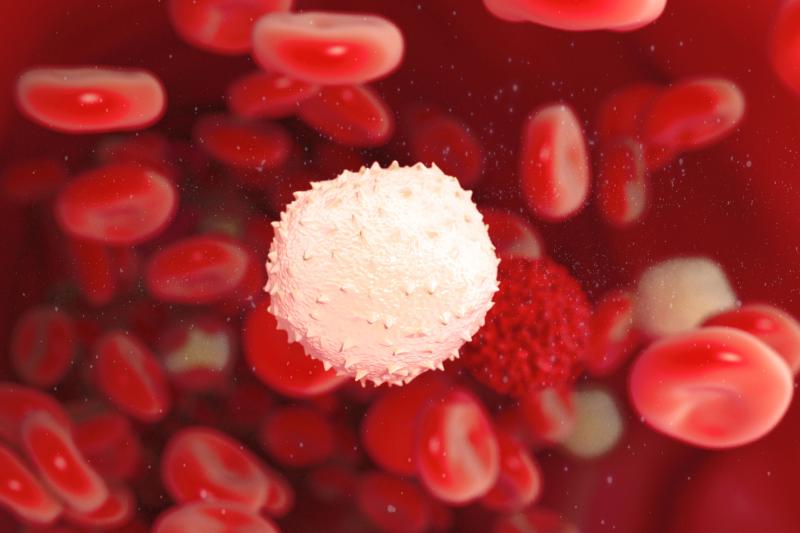Bispecific antibody delivers positive results in relapsed, refractory multiple myeloma





A large percentage of patients with relapsed/refractory multiple myeloma (RRMM) respond to the bispecific antibody linvoseltamab, with deep and durable responses seen even in the high-risk subgroups, according to data from the phase I/II LINKER-MM1 trial.
In a cohort of heavily pretreated RRMM patients, the objective response rate (ORR) with linvoseltamab was 71 percent, including 46 percent of those who achieved complete response (CR) or better, reported Dr Sundar Jagannath from the Icahn School of Medicine at Mount Sinai in New York City, New York, US.
Around 39 percent of patients with CR also tested negative for minimal residual disease, Jagannath added.
High response rates were maintained across most high-risk subgroups, except patients with extra-medullary plasmacytoma (ORR 52.6 percent), those with bone marrow plasma-cell percentage of at least 50 (ORR 48.1 percent), and those with soluble BCMA ≥400 ng/mL (ORR 55.8 percent).
The median time to response was quick, with patients showing at least a partial response within a median of 1 month, Jagannath noted. More importantly, responses to linvoseltamab deepened over time, and 48 percent of patients who initially had a very good partial response achieved CR following a switch from 2-week to 4-week dosing, he added.
On Kaplan-Meier analysis, the median duration of response (DOR), progression-free survival (PFS), and overall survival (OS) were not reached. The probability of maintaining a response at 12 months was 78 percent, while the 12-month PFS and OS estimates were 68.8 percent (95 percent confidence interval [CI], 58.3–77.1) and 74.5 percent (95 percent CI, 64.9–81.8), respectively.
Acceptable safety
Linvoseltamab had an acceptable safety profile, with cytokine release syndrome (CRS; any grade: 46 percent, grade 2: 10 percent, grade 3: 1 percent, grade 4: 0 percent) being the most common treatment emergent adverse event (TEAE), according to Jagannath. CRS occurred mostly during the step-up dosing, with a median time to onset of 11 hours.
Other TEAEs reported were neutropenia (any grade: 41 percent, grade 3–4: 40 percent), anaemia (any grade: 39 percent, grade 3–4: 31 percent), cough (any grade: 36 percent, grade 3–4: 0 percent), and diarrhoea (any grade: 35 percent, grade 3–4: 2 percent).
Infections occurred in 73 percent of patients, including grade 3-4 infections in 34 percent. Jagannath noted that the frequency and severity of infections decreased after 6 months, coincident with 4-week linvoseltamab dosing.
Linvoseltamab is an investigational fully human B-cell maturation antigen (BCMA)/CD3 antibody, requiring two 1-day hospitalizations and allowing monthly dosing for patients who achieve deep responses, according to Jagannath.
“Bispecifics are effective, off-the-shelf treatment option for patients with heavily pretreated MM. Currently available BCMA/CD3 bispecifics have an ORR ranging between 61 percent and 63 percent,” he continued.
The findings of the present study indicate that linvoseltamab is highly efficacious in patients with late-stage RRMM, including those in high-risk subgroups, Jagannath said.
LINKER-MM1 included 117 patients (median age 70 years, 17 percent African American) who had been exposed to a median of five prior lines of therapy. Most patients (82.1 percent) were at least triple-refractory, 65.8 percent were at least quad-refractory, and 28.2 percent were at least penta-refractory.
The patients received intravenous linvoseltamab at 5 mg on day 1, then at 25 mg on day 8 during the step-up dosing phase (week 1-2). Starting at week 3, the drug was administered at 200 mg once a week through week 14, then once every 2 weeks thereafter. Those who achieved at least a very good partial response after ≥24 weeks of treatment were switched to 4-week dosing.
The phase III LINKER-MM3 trial of linvoseltamab for RRMM is ongoing, Jagannath said.